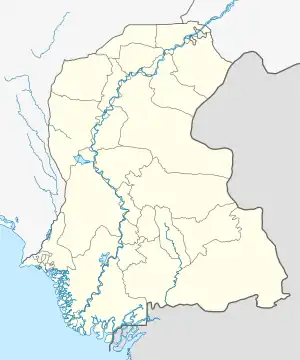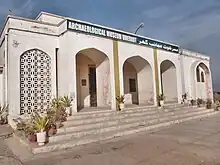Umerkot (Amarkot)
| |
|---|---|
 The 11th century Umarkot Fort | |
 Umerkot (Amarkot) Location of Umarkot  Umerkot (Amarkot) Umerkot (Amarkot) (Pakistan) | |
| Coordinates: 25°21′47″N 69°44′33″E / 25.36306°N 69.74250°E | |
| Country | |
| Province | |
| Division | Mirpur Khas |
| District | Umarkot |
| Metropolitan Corporation | Pre-islamic |
| Government | |
| • Body | District Government |
| • Deputy Commissioner | Tahir Ali Memon[1] |
| Area | |
| • City | 48.6 km2 (18.8 sq mi) |
| Population | |
| • City | 134,052 |
| • Rank | 68th, Pakistan |
| • Density | 2,800/km2 (7,100/sq mi) |
| Time zone | UTC+05:00 (PKT) |
| Postal code | 69100 |
| Dialling code | 238 |

Umerkot (Urdu: عمركوٹ; Sindhi: عمرڪوٽ; IPA: [ʊmərkoːʈ], formerly known as Amarkot) is a city in the Sindh province of Pakistan. The 3rd Mughal emperor Akbar was born at Umerkot in 1542.
The local language is Dhatki, one of the Rajasthani languages of the Indo-Aryan language family. It is most closely related to Marwari. Sindhi, Urdu and Punjabi are also understood by the citizens.
Etymology

The city is named after a local ruler of Sindh, Umer Soomro (of Soomra dynasty ) of the Umar Marvi story, which also appears in Shah Jo Risalo one of the popular tragic romances of Sindh.[3] However, the myth of Umer Marvi is believed to have been made up to islamise the history of Amarkot, which was named after its original founder, Amar Singh.[4]
History
Amarkot province was ruled by the Sodha Rajput clan during the medieval period.[5] Rana Parshad, the Sodha Rajput ruler of Umarkot, gave refuge to Humayun, the second Mughal Emperor when he was ousted by Sher Shah Suri, and the following Mughal Emperor, Akbar, was born here.[6] Later on, Akbar brought northwestern India, including modern Pakistan, under Mughal rule.
After the disintegration of the Mughal Empire, Amarkot was captured by several regional powers, including the Persians, Afghans, Kalhora and Talpur Balochis of Sindh, Rathore Rajputs of Jodhpur and finally by the British.[7]
Amarkot was annexed by Jodhpur State in 1779 from the Kalhora nawab of Sindh[7] Umerkot and its fort was traded to the British in 1843 by the Maharaja of Jodhpur in return for a Rs.10,000 reduction in the tribute imposed on Jodhpur State.[8] The British appointed Syed Mohammad Ali governor of the province. In 1847, Rana Ratan Singh was hanged at the fort by the British, for killing Syed Mohammad Ali in a tax protest.[9]
After the British conquered Sindh, they made it part of the Bombay Presidency of British India. In 1858, the entire area around Tharparkar became part of the Hyderabad District. In 1860 the region was renamed Eastern Sindh Frontier, with a headquarters at Amarkot. In 1882, it was reorganized as the Thar and Parkar district, headed by a British Deputy Commissioner, with a political superintendent at Amarkot.[10] However, in 1906 the district headquarters moved from Amarkot to Mirpur Khas.
Rana Chandra Singh, a federal minister and the chieftain of the Hindu Sodha Thakur Rajput clan and the Amarkot Jagir, was one of the founding members of the Pakistan Peoples Party (PPP) and was elected to the National Assembly of Pakistan from Umarkot seven times as a PPP member between 1977 and 1999, when he founded the Pakistan Hindu Party (PHP).[11][12] Currently, his politician son Rana Hamir Singh claims to be the 26th Rana of Tharparkar, Umarkot and Mithi.[13][14]
Points of interest
The city is well connected with the other large cities like Karachi, the provincial capital and Hyderabad.[15]
Umarkot has many sites of historical significance such as Akbar's birthplace, Umarkot, Umerkot Fort and Momal Ji Mari.
There is an ancient temple, Shiv Mandir, Umerkot, as well as a Kali Mata Temple, Krishna Mandir at old Amarkot and Manhar Mandir Kathwari Mandir at Rancho Line.
Education
The city has more than 100 schools, 20 colleges, and one polytechnic college.
Religion
The Umarkot Shiv Mandir is one of the most ancient and sacred Hindu temples in Sindh.[16]
| Religion | Population (1901)[17] | Percentage (1901) |
|---|---|---|
| Hinduism |
3,884 | 78.72% |
| Islam |
993 | 20.13% |
| Jainism |
46 | 0.93% |
| Christianity |
1 | 0.02% |
| Total | 4934 | 100% |
See also
Gallery
 Umerkot Fort
Umerkot Fort Umerkot Museum
Umerkot Museum
Notes
References
- ↑ "SAU Umerkot campus graduated first batch". The Academia Magazine. 9 December 2021. Retrieved 8 January 2021.
- ↑ "PAKISTAN: Provinces and Major Cities". PAKISTAN: Provinces and Major Cities. citypopulation.de. Retrieved 4 May 2020.
- ↑ Shaikh Khurshid Hasan (1 January 2005). Historical Forts In Pakistan. National Institute of Historical & Cultural Research Centre of Excellence, Quaid-i-Azam University. ISBN 978-969-415-069-7.
- ↑ Taha Siddiqui (16 January 2015). "Footprints: Once upon a time in Umerkot". Dawn.
- ↑ Part 10:..the birth of Akbar Humayun nama by Gulbadan Begum.
- ↑ Part 10:..the birth of Akbar Humayun-nama by Gulbadan Begum.
- 1 2 https://researcharchive.vuw.ac.nz/xmlui/bitstream/handle/10063/8776/thesis.pdf?sequence=1
- ↑ "Imperial Gazetteer2 of India, Volume 14, page 186 -- Imperial Gazetteer of India -- Digital South Asia Library".
- ↑ Hasan, Shazia (19 April 2015). "Umerkot: Lost in history". DAWN.COM. Retrieved 16 July 2022.
- ↑ David Ross C.I.E., The land of the five rivers and Sindh (1883), p. 33
- ↑ "Hindu Leader, Ex-minister Chardar Singh is Dead". Khaleej Times. 3 August 2009. Archived from the original on 8 June 2011. Retrieved 3 August 2009.
- ↑ Guriro, Amar (2 August 2009). "Chieftain of Pakistani Hindu Thakurs dies". Daily Times. Retrieved 2 August 2009.
- ↑ Footprints: Once upon a time in Umerkot, Dawn (newspaper), 16 January 2015.
- ↑ Pakistan's Umerkot gets a new Hindu ruler, The Hindu, 30 May 2010.
- ↑ "District Government Umerkot". Archived from the original on 24 February 2012. Retrieved 16 February 2014.
- ↑ "The thriving Shiva festival in Umarkot is a reminder of Sindh's Hindu heritage". 27 February 2018. Retrieved 18 February 2021.
- ↑ Enthoven, R. E. (1902). Census of India, 1901: Volume IX-A. Bombay: Part II, Imperial Tables. Government Central Press. pp. 40–41.